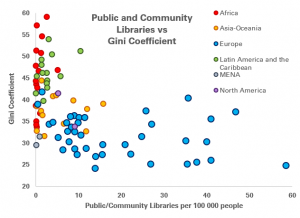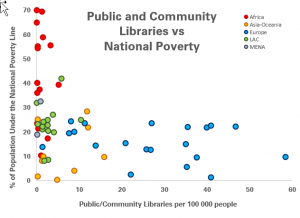Much of the discussion about eBooks in libraries focuses on the situation for public libraries. With scholarly publishing having switched to digital formats relatively early, it can be easy to assume that all is well. However, with the COVID-19 pandemic forcing academic libraries to close their doors, it has become clear that this is not the case.
To find out more about the situation, we interviewed Johanna Anderson, an academic librarian and public library advocate from the United Kingdom, to find out more. You can follow Johanna on Twitter.
1. How have you and colleagues experienced the closure of your buildings to the public?
Lectures and teaching were moved online over a week before our libraries were closed. We were not closed until the end of the Tuesday after the government’s instructions to close campuses, and before this saw a bit of a dash to the library by students to get books, laptops etc.
Since then we have been working to try to get alternative ebook titles of key texts not available in electronic format as we can’t get onto campus to do scanning, and have spent hours trawling provider platforms for affordable eBooks. We have also been doing literature search tutorials with students online, and have also compiled a list of additional resources made temporarily available by publishers.
This has taken quite a lot of work as they tend to be on unfamiliar platforms to us and the students. Students already find literature searching complicated so all of these additional platforms and the inherent difference in access limits has added to that complication. We are doing what we can to help students navigate them.
The most difficult thing is making students aware of the resources in the first place as they are pretty swamped with trying to adjust to the changes in circumstances already and they are pretty stressed – not ideal for processing new information
2. How much use was being made of academic eBooks before the crisis? What lay behind this?
It’s hard to get exact figures at the moment due to circumstances but students tend to prefer hardcopy books and our hardcopy stock circulation statistics are very high. This is partly due to the nature of the text heavy courses we deliver, e.g. social sciences and humanities.
Nonetheless, there is demand – where we do have eBooks available they are heavily used. Therefore, for ANY title we have on reading lists we will ALWAYS buy eBooks where possible rather than hardcopy. However, we did do an audit of one of our schools and for our computing courses only 17% of titles on the reading lists were available in electronic format. The figure is far lower on humanity courses.
3. To what extent are eBook versions of texts available for you to buy for the library?
This kind of ties into the above. We are about on par with the figures in the report prepared by UK Copyright Literacy on the value of the Copyright Licencing Agency (CLA)’s licence to UK Higher Education.
This noted, in particular, that “in an audit of most frequently scanned books, of the 904, 902 were recognised by the ProQuest database, and 94 (10%) were identified as ISBNs with an electronic alternative. This chimes with other estimates that only around 10% of current academic titles are available as eBooks.” (pg 24).
The table on page 26 is very useful in illustrating the issues we have with licencing models as it shows that single user licence eBooks dominated scan requests and were also the most available licence when ebook purchasing. The average costs are also pretty depressing.
There is a danger in seeing the CLA licence used to provide key chapters of books to a large cohort of students, and equating that as a viable alternative to resourcing a library with complete books.
This issue is skimmed over in the report, but for me, this is just not a sensible collection management approach. We do currently make the best use of the CLA licence that we can, but it is not enough.
Of course, eBook versions of texts may be available through publishers’ own platforms, but this is not a realistic option given that we need to offer readers a range of books, from many different publishers. We simply cannot afford to buy into every platform going, so we have to rely on aggregate vendors who are currently not in a position to negotiate reasonable prices that libraries can afford.
4. To what extent have you come across contractual barriers, such as limitations on where copies can be accessed?
Previous to the COVID-19 crisis, eBook purchasing was a nightmare. We have had cases of vendors selling us licences which publishers have then restricted access to or withdrawn, which quite frankly, is disgusting.
A lot of the key texts e.g. research methods ones are not available in ebook format at all as discussed above. Many books, as CLA points out, are single user only books… which are often ten times the price of a hardcopy. Students will not use them if, when they click on a book title, they are told they cannot read it at that time.
Students, and indeed most academics, do not understand the restrictions – it is no surprise as this is so complicated. They think “e” = available to them anytime and anywhere. We do not have the budgets to buy eBooks whatever the cost, so librarians spend HOURS trawling through complicated licences on different platforms.
Furthermore, the price of eBooks varies wildly with no obvious rhyme or reason. More recently Taylor and Francis/Routledge have increased the price of their eBooks up to sometimes as much as 10x the original price (as I’ve highlighted on my Twitter feed) and some are starting to introduce “expiry dates” so the licence to a purchased eBook expires after a year. This is perverse!
Moreover, we cannot collectively complain because contract terms prevent us from sharing this sort of information. Who knows what they are charging other universities!
5. To what extent are they affordable? How do they compare to physical versions of the same books
As set out above and in the report about the CLA licence, it is not easy to answer because there is so much variation, not just by publisher but also by discipline.
For example, Sage doesn’t tend to publish things in electronic format (which is very annoying, given that their materials are heavily needed by teaching students etc who spend most of their time on placement). When they do, they tend to be single user licences only, but are a similar price to the hardcopy.
Then you get publishers like Taylor and Francis who will sell a hardcopy book for £30-40, but charge are £400 + for a single user ebook. Incidentally, these same titles were approximately £120-£180 before Christmas, which was already high. Nonetheless, as I said at the beginning, prices vary so much that it is difficult to give a straightforward answer to this one.
6. What reasons have you been given for the high prices?
Publishers say that promoting eBook formats leads to a reduction in their income because multiple hardcopies are no longer purchased, although this seems hard to square with the regular high profits that many of them continue to enjoy. It also makes no sense as we cannot afford these prices even if we wanted to, so I am not buying from them at all! I’m not sure how this will help their bottom line! I am told that much of the process of producing a book is often outsourced in order to reduce costs, so I can’t see how they cost more than hardcopy books.
If there was a single user eBook at the same price as a hardcopy I would buy a couple of licences, and I know that JISC have had some communications with T&F about this
7. Do these make much sense in the current circumstances?
It doesn’t make sense in any circumstances. This has just magnified the issue! I have been complaining for months. People are only taking note now as it is making a difficult situation worse. Taylor and Francis announced to much fanfare that they are going to allow libraries to buy their single user eBooks with temporary unlimited access. This is no help at all as we still can’t afford them! I also have no intention of being stuck with single user ebooks I had to pay hundreds for after all of this. It just isn’t practical.
8. What impact does this have on you in your job, and on your budgets?
It has been very frustrating and stressful… things are tricky enough already! Students panicked and rushed to the library to get hardcopy texts before we shut down, which is absolutely what should not have had to happen in the current circumstances. As I have already said, I have spent hours and hours trying to find alternative eBooks, often to no avail. Taylor and Francis have not made their pricing more reasonable so I can see eBooks are there but I cannot buy them. It’s so frustrating!
There is a myth, particularly among university management, that everything is available in electronic format. This is often used as a reason for the reduction of physical space in libraries, but it really is not the reality. When things ARE available in electronic format the publishers can change the terms or withdraw items and there isn’t anything we can do about it. Currently, we simply do not have the negotiating power to change this.

